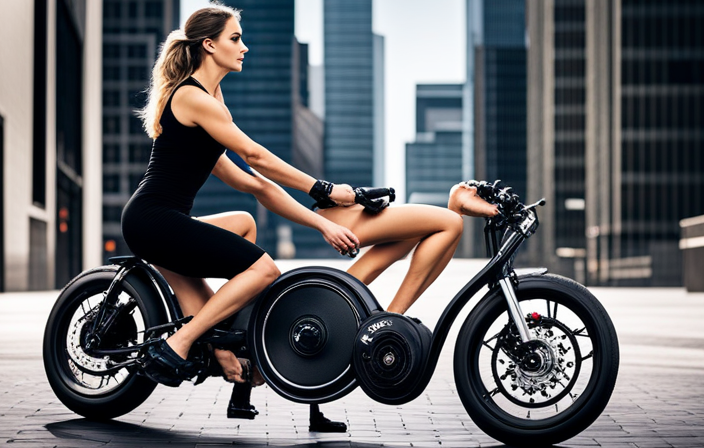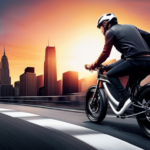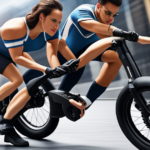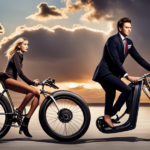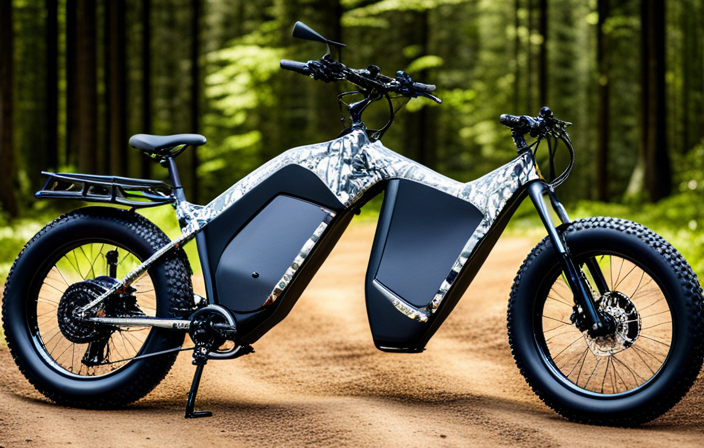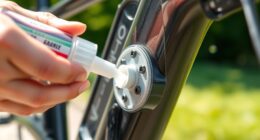I’ve always been passionate about cycling, and recently, I’ve noticed a surge in women’s electric bikes on the market. With their sleek design and eco-friendly features, it’s no wonder they’re gaining popularity.
However, understanding how to effectively use the brakes on these bikes is crucial for a safe and enjoyable ride. In this article, I’ll share my expertise on the different types of brakes, proper hand placement, and techniques for smoother stops.
So, let’s dive in and master the art of braking on a women’s electric bike!
Key Takeaways
- Progressive braking technique is important for effectively slowing down and maintaining control over the bike.
- ABS braking, which relies on the Anti-lock Braking System, ensures stability while stopping and promotes safe braking.
- When braking on different surfaces, it is important to adjust the braking technique for optimal safety and maintain stability.
- When braking on steep inclines, using both the front and rear brakes helps prevent flipping over and ensures stability while descending.
Understanding the Different Types of Brakes on a Women’s Electric Bike
There are two main types of brakes on a women’s electric bike: rim brakes and disc brakes.
Rim brakes work by applying friction to the rim of the wheel to slow down or stop the bike. They are commonly found on older electric bikes and require regular maintenance and care to ensure optimal performance.
On the other hand, disc brakes use a rotor attached to the wheel hub and calipers that squeeze the rotor to slow down or stop the bike. They provide better stopping power and are more resistant to wet conditions.
When it comes to hand grip techniques, it is important to have a firm and secure grip on the handlebars to ensure effective braking.
As for brake maintenance and care, regular inspections of the brake pads, cables, and calipers are necessary to ensure they are in good working condition.
Proper hand placement for effective braking is crucial to ensure your safety on the road.
Proper Hand Placement for Effective Braking
To achieve effective braking, it’s important to place your hands properly on the handlebars of your electric bike. Follow these hand placement techniques for optimal control and safety:
- Keep your hands on the handlebars at all times, with fingers covering the brake levers.
- Position your hands near the ends of the handlebars, allowing for maximum leverage and control.
- Maintain a firm grip on the handlebars, ensuring that your hands do not slip during braking maneuvers.
By placing your hands correctly, you can quickly and efficiently engage the brakes when needed, reducing the risk of accidents and improving your overall biking experience.
Now, let’s move on to adjusting brake tension for optimal performance, which will further enhance your braking abilities without compromising safety.
Adjusting Brake Tension for Optimal Performance
Make sure you adjust the tension of your brake levers correctly for optimal performance on your electric bike.
The first step is to locate the tension adjustment screw on the brake lever. This screw allows you to control the distance between the brake lever and the handlebar grip.
By turning the screw clockwise, you can increase the tension, making it easier to engage the brakes. Conversely, turning it counterclockwise will decrease the tension.
Adjust the tension so that you have a firm grip on the brake lever without having to strain your fingers.
If you find that your brake lever still feels loose even after adjusting the tension, it may be time to replace the brake pads.
Now that your brake levers are properly adjusted, you can move on to using your front and rear brakes in combination for maximum stopping power.
Using Front and Rear Brakes in Combination
When riding your electric bike, it’s important to combine the front and rear brakes for maximum stopping power. To ensure the brakes are working at their best, regular brake maintenance is essential.
This includes checking the brake pads for wear and replacing them when necessary. Brake pads wear down over time due to the friction created when braking. You can easily inspect the brake pads by looking through the slots in the brake calipers. If the pads are less than 3mm thick, it’s time for a replacement.
Simply remove the old pads and insert new ones, making sure they are properly aligned with the brake track. By maintaining your brakes and replacing worn brake pads, you can ensure your electric bike stops efficiently and safely.
Now, let’s explore gradual braking techniques for smoother stops.
Gradual Braking Techniques for Smoother Stops
By gradually applying pressure to the brake levers, you can achieve smoother stops on your e-bike. This technique is especially important when navigating steep descents or riding in wet or slippery conditions.
When it comes to braking on steep descents, it’s crucial to use both the front and rear brakes in combination to evenly distribute the braking force and prevent the wheels from locking up.
In wet or slippery conditions, you should apply the brakes gently and avoid sudden or harsh braking to maintain traction and prevent skidding. Remember to keep your body centered and your weight balanced to ensure maximum control.
Anticipating and reacting to potential hazards is the next essential skill we’ll explore in ensuring a safe and enjoyable ride.
Anticipating and Reacting to Potential Hazards
Anticipating and reacting to potential hazards is crucial for maintaining a safe and enjoyable ride on your e-bike. When riding, it’s important to always be aware of your surroundings and maintain a proactive mindset. Your reaction time can make a significant difference in emergency situations.
By staying focused and attentive, you can quickly respond to any unexpected obstacles or dangers that may arise. It is essential to keep a safe distance from other vehicles and pedestrians, allowing yourself enough time to react and maneuver accordingly. Additionally, being aware of road conditions, such as potholes or slippery surfaces, can help you anticipate potential hazards and adjust your speed or direction accordingly.
Maintaining and Inspecting Your Brakes Regularly
To ensure your safety, regularly maintaining and inspecting your e-bike’s brakes is of utmost importance. Proper brake maintenance and inspection will not only extend the lifespan of your brakes but also ensure they are functioning optimally when you need them the most. Here is a quick guide on how to properly maintain and inspect your e-bike’s brakes:
| Brake Maintenance and Inspection |
|---|
| 1. Check brake pads for wear and replace if necessary |
| 2. Inspect brake cables for fraying or damage |
| 3. Ensure brake levers are properly adjusted and responsive |
Avoiding Overheating and Brake Fade
Make sure you regularly check your brake pads for wear and replace them if necessary to prevent overheating and brake fade.
Brake fade occurs when the brakes become too hot and lose their effectiveness, resulting in a longer stopping distance and decreased control over your electric bike.
Signs of overheating include a burning smell, excessive brake pedal travel, or a spongy feeling when applying the brakes.
To prevent brake fade, it’s important to use the correct braking technique. Apply the brakes gradually and evenly, rather than slamming them on suddenly. This allows the heat to dissipate more effectively and prevents the pads from overheating.
Practicing Emergency Braking Maneuvers
Practicing emergency braking maneuvers helps improve your ability to stop quickly and safely, reducing the risk of accidents. Here are three essential emergency braking techniques to master:
-
Progressive Braking: Gradually apply the brakes to avoid locking the wheels and maintain control over the bike. Start with light pressure and increase it progressively to slow down effectively.
-
ABS Braking: If your electric bike is equipped with an Anti-lock Braking System (ABS), rely on it to prevent wheel lock-up. ABS automatically modulates the brake pressure, allowing you to maintain stability while stopping.
-
Braking on Wet Surfaces: Wet roads can significantly affect braking efficiency. To brake safely on wet surfaces, apply the brakes gently and avoid sudden or aggressive movements. Allow more time and distance to come to a complete stop.
By practicing these emergency braking techniques, you’ll be better prepared to handle unexpected situations.
Now, let’s explore tips for braking on different terrains, ensuring your safety in various riding conditions.
Tips for Braking on Different Terrains
After mastering emergency braking maneuvers on my women’s electric bike, I am now ready to delve into the intricacies of braking on different terrains.
It is crucial to understand how to adapt my braking technique to ensure optimal safety and control in various conditions.
When facing wet surfaces, such as slippery roads or muddy trails, I must apply the brakes gently and gradually to prevent skidding and maintain stability.
Additionally, when encountering steep inclines, I need to be cautious and use both the front and rear brakes simultaneously to evenly distribute the braking force and avoid the risk of flipping over.
Frequently Asked Questions
How often should I inspect and maintain my brakes on a women’s electric bike?
I inspect and maintain the brakes on my women’s electric bike according to a regular brake maintenance schedule. This helps prevent common brake issues such as worn brake pads, loose cables, or misaligned calipers.
What are some signs of overheating or brake fade that I should be aware of?
Signs of brake overheating include a burning smell, reduced braking power, and a spongy brake lever. Prevent brake fade by avoiding prolonged and excessive braking, using both brakes evenly, and allowing them to cool down between heavy use.
Are there any specific emergency braking maneuvers that I should practice on a women’s electric bike?
To ensure safety during emergencies, practicing emergency braking techniques on a women’s electric bike is crucial. Some braking tips for these bikes include applying firm pressure to the brakes, gradually increasing braking force, and maintaining a proper body position for maximum control.
How do I adjust the brake tension on a women’s electric bike for optimal performance?
To adjust the brake tension on a women’s electric bike for optimal performance, I recommend locating the brake lever adjustment barrel near the brake lever. Rotate it clockwise to increase tension and counterclockwise to decrease tension until you achieve the desired performance.
Can I use the front and rear brakes simultaneously for quicker stops on a women’s electric bike?
Using both brakes simultaneously is a crucial braking technique for quicker stops on a women’s electric bike. Remember the adage "Two is better than one" to ensure optimal performance and safety.
Conclusion
In conclusion, mastering the art of braking on a women’s electric bike is crucial for a safe and enjoyable riding experience.
By understanding the different types of brakes and properly adjusting their tension, riders can achieve optimal performance.
Combining front and rear brakes, practicing gradual braking techniques, and regularly maintaining and inspecting the brakes are all essential steps.
Remember, brakes are the lifeline of your bike, so don’t let them fade away like a distant memory. Keep them in top shape and ride with confidence on any terrain.
